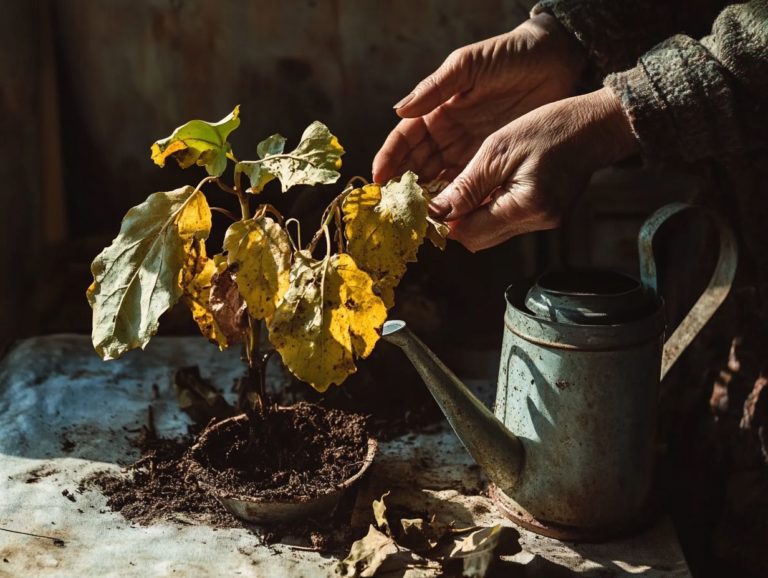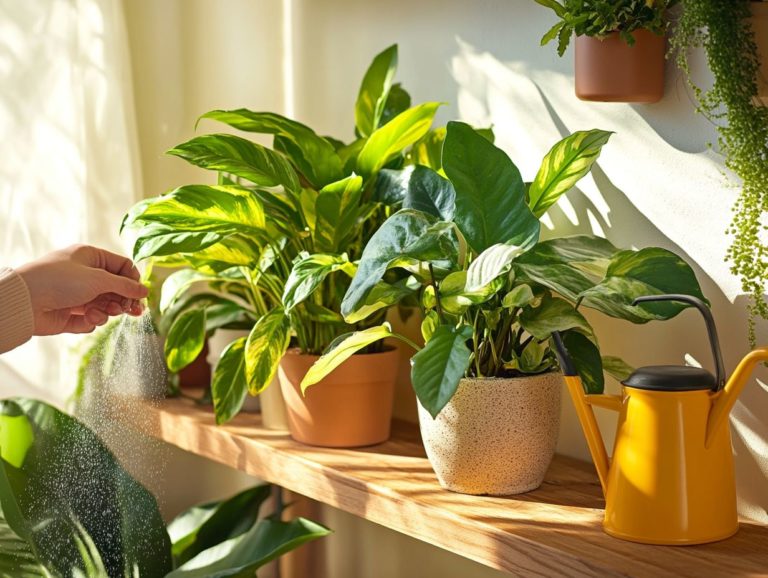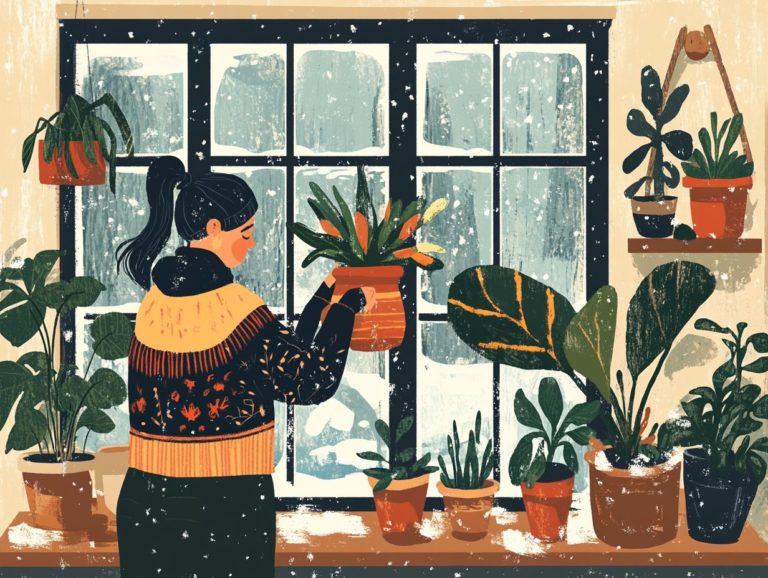Indoor Plant Care Mistakes and Solutions
Houseplants infuse your home with life and vibrancy! Nurturing them can be more complex than it appears.
Many plant lovers inadvertently stumble into common traps, like overwatering or selecting unsuitable soil types.
Let s uncover the secrets to thriving houseplants! This article highlights prevalent indoor plant care mistakes and offers practical solutions to help you cultivate your houseplants with confidence.
Whether you’re a seasoned gardener or just starting your green journey, understanding these essentials will ensure your indoor plants thrive and remain healthy.
Contents
Key Takeaways:
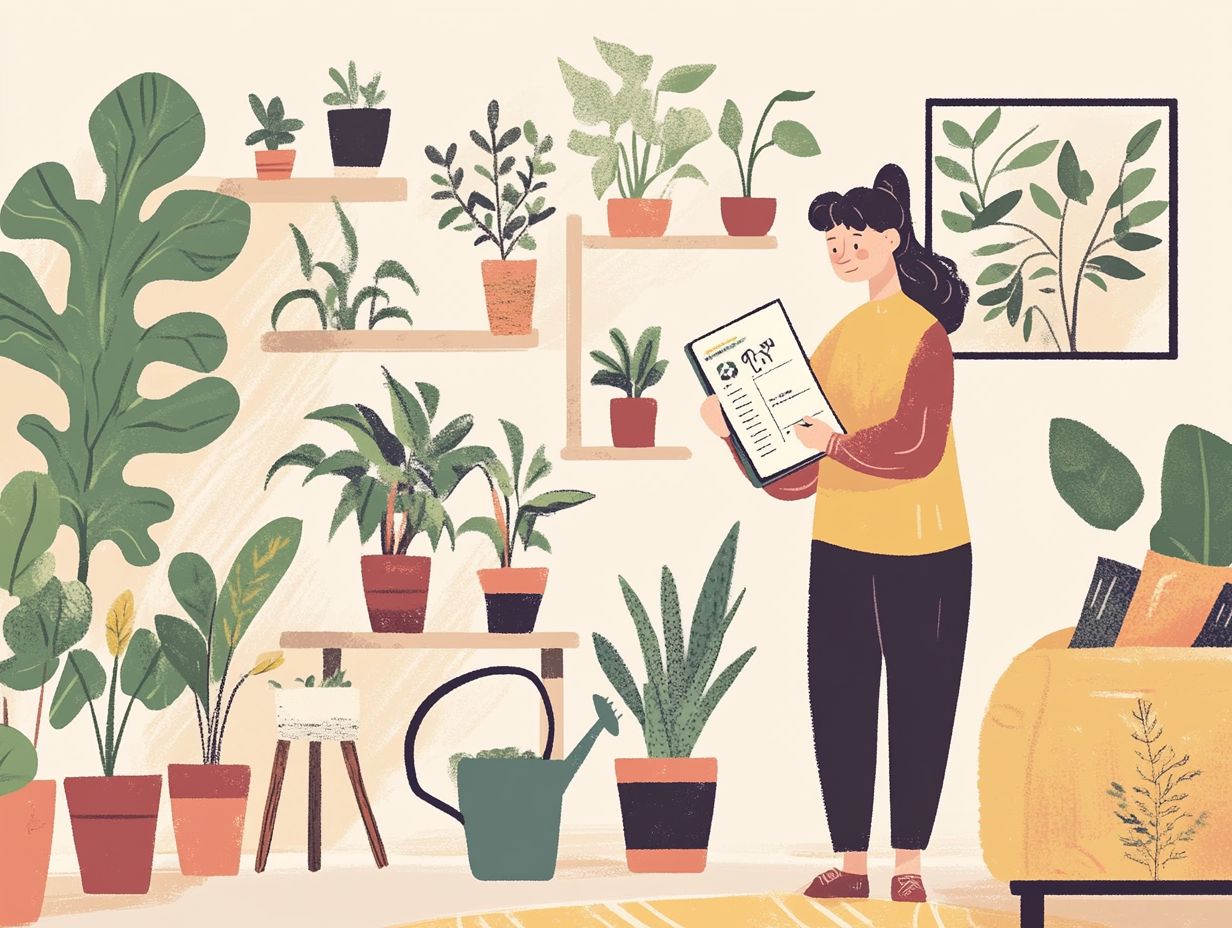
- Overwatering is a common mistake that can lead to root rot (a condition where roots decay due to excessive moisture) and other issues. Always check the soil moisture and drainage holes before watering and ensure proper pot drainage.
- Underwatering can cause leaf wilting and stunted growth. Develop a watering schedule based on your plant’s needs and check the soil regularly to ensure it is not dry.
- Insufficient light conditions and improper temperature can hinder plant growth. Research your plant’s specific light exposure and temperature requirements and make adjustments as needed.
Common Indoor Plant Care Mistakes
Indoor gardening with houseplants can bring vibrant energy to your home. However, many plant lovers make common mistakes that threaten their plants’ health and longevity. Overwatering is a prevalent misstep that often leads to root rot, while underwatering can stunt growth and result in unsightly wilting leaves. Moreover, inadequate lighting and improper pot drainage can significantly disrupt the plant’s environment.
To help your tropical plants thrive, know their specific needs, including humidity levels and soil types, as well as proper plant food and pot size. By avoiding the top 7 mistakes in indoor plant propagation and being mindful of light exposure, you can cultivate a green thumb that effectively nurtures your indoor plant collection.
Overwatering
Overwatering stands out as one of the most frequent missteps in indoor plant care, often leading to dire consequences like root rot and languishing plants. This predicament frequently stems from a misunderstanding of moisture levels and the critical role soil drainage plays in nurturing plant health. Signs of overwatering include yellowing leaves, stunted growth, or an unsettling musty odor emanating from the soil.
To avoid these issues, routinely check for drainage holes at the bottom of your pots. These openings allow excess water to escape, keeping the soil from becoming overly saturated. If your plant’s pot doesn t have sufficient drainage, adjust your watering schedule accordingly.
Also, consider using decorative pots that enhance drainage options, promoting healthier growth and vitality for your cherished greenery.
Underwatering
Underwatering may often slip under the radar, but it can significantly impede your plants’ growth, manifesting through telltale signs like wilting leaves and stunted development.
This condition doesn’t just mar your plant’s appearance; it can also lead to nutrient deficiencies, compromising your greenery’s overall health. Paying attention to how your plants respond to their environment is crucial. If you notice issues, it’s important to know when to worry about your indoor plant. Many species flourish in specific humidity levels, which play a vital role in retaining moisture in the soil and enhancing photosynthesis.
Establishing a consistent watering schedule tailored to each type of plant ensures they receive the hydration they need for optimal growth. Act now to adapt your care routines based on individual requirements, such as monitoring soil drainage for succulents or increasing humidity for tropical plants, ultimately fostering a thriving indoor oasis.
Finally, we invite you to share your plant care tips or experiences! Join our community and help others cultivate their indoor gardens.
Insufficient Light
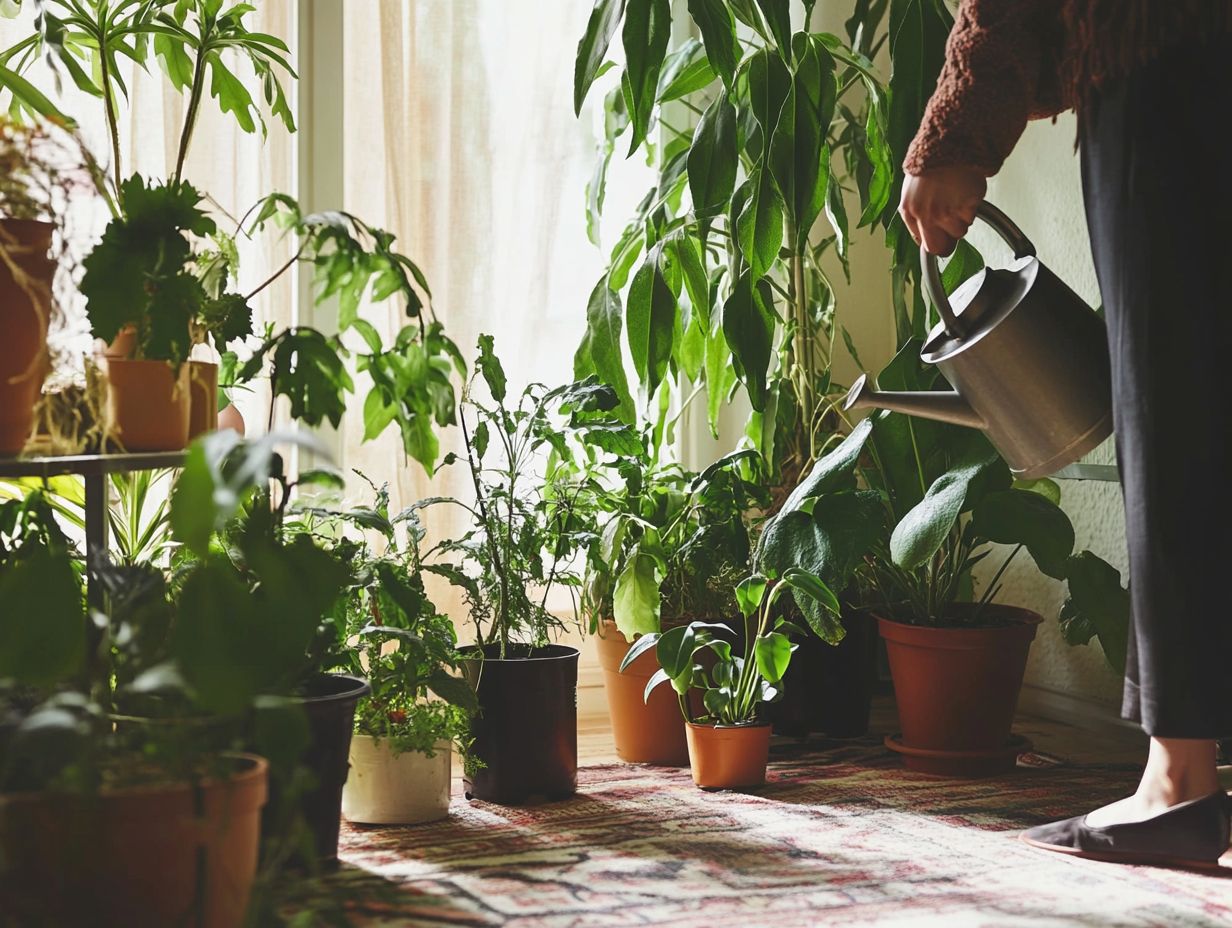
Insufficient light is crucial for your houseplants. Each species has its own unique light exposure needs.
When those lighting needs aren’t met, you might notice stunted growth, yellowing leaves, and a general lack of health in your plants. This inefficiency not only hampers their growth but can also make them prone to issues like root rot. For effective solutions, consider these top tips for indoor plant care troubleshooting, as weakened plants become more vulnerable to pests and diseases.
To tackle these challenges, consider repositioning your plants to brighter spots or supplementing natural light with grow lights, which help plants grow indoors. If you’re looking for low-light warriors, species like the snake plant and pothos are particularly well-suited for dimly lit areas. However, if you encounter persistent issues, you might want to refer to indoor plant problems: when to seek help, making these plants perfect choices for your space.
Improper Temperature
Maintaining the proper temperature is essential for your indoor plant care. An improper temperature can induce stress and sabotage your plants well-being.
For tropical houseplants, aim for that sweet spot between 65 F and 80 F. This range creates a cozy environment where these plants can truly thrive.
They can be very sensitive to temperature changes, so it’s important to monitor both daytime and nighttime temperatures closely. As the colder months roll in, make it a habit to place your plants away from drafty windows or doors to shield them from chilly gusts. For more guidance, check out indoor plant care troubleshooting for common issues.
A thermometer is your best friend here; it helps you monitor your indoor climate closely to give your plants the best care possible! Adjusting heating sources or using fans can help create a more stable environment for your plants.
By staying attuned to these seasonal changes, you can ensure your plants remain healthy and vibrant all year round. Start paying attention to your plants temperature needs today!
Wrong Soil Type
Using the wrong soil type can seriously hinder your houseplants’ growth and affect their ability to absorb essential nutrients and retain moisture.
Choosing the right soil is vital because every plant comes with its own set of unique requirements. For instance, orchids flourish in well-draining substrates, often favoring a mix that includes bark, perlite, and moss to replicate their natural habitat.
On the other hand, pothos prefers a richer, loamy soil that ensures adequate moisture retention while providing necessary drainage for healthy plants. Don t overlook the importance of pot size and drainage holes; the right pot size prevents root stifling, while adequate drainage holes prevent waterlogging, which could lead to root rot.
By paying close attention to these details, you can significantly enhance the health and vitality of your houseplants. Start choosing the right soil for your plants today!
Incorrect Pruning Techniques
Incorrect pruning techniques can lead to unhealthy plants, stunted growth, and a less appealing appearance. It s essential for you as a plant parent to master the proper methods.
Understanding the right time and technique to prune can significantly enhance the vitality and appearance of your greenery, both indoors and outdoors. Proper pruning promotes healthier growth and encourages more vibrant blooms, ensuring that your plants truly thrive.
Whether you’re a novice or a seasoned gardener, evaluating your plant’s structure and removing dead or diseased branches can create space for new growth. If you’re noticing signs of aging in indoor plants, addressing these issues promptly is crucial. Engaging with the houseplant community can provide you with invaluable insights and creative strategies, as fellow enthusiasts are always eager to share tips and resources that elevate your gardening knowledge.
Together, you can cultivate a supportive network that nurtures a flourishing gardening culture. Start exploring pruning techniques today!
Solutions for Indoor Plant Care Mistakes

To guarantee the longevity of your houseplants and steer clear of typical indoor plant care missteps, it’s essential to adopt effective solutions. Start implementing these changes today!
How to Correctly Water Indoor Plants
Correctly watering your indoor plants is crucial for maintaining optimal moisture levels and ensuring proper pot drainage. Both are vital for the overall health of your plants.
To achieve this, grasp the specific requirements of each plant species, as their needs can vary significantly. Generally, indoor plants thrive on a consistent watering routine. However, factors like light exposure and temperature should guide how often you water. Most plants do well with a weekly watering schedule, but be mindful of the top 7 mistakes in watering indoor plants to ensure success. Stay alert for signs of overwatering or underwatering—your plants will thank you!
Use techniques like a moisture meter or inserting your finger a couple of inches into the soil to determine when it’s time to water. Check your plant’s leaves! Wilting or yellowing are clear signals that something’s off.
Providing Adequate Light and Temperature
Providing the right light and temperature is essential for ensuring your houseplants flourish.
To optimize these conditions, consider the specific requirements of each plant type. For example, tropical plants thrive in bright, indirect light and prefer warmer temperatures. In contrast, succulents and cacti love direct sunlight and can handle higher heat levels. Additionally, incorporating indoor plant pest prevention tips can help ensure your plants remain healthy and vibrant.
In winter, reposition your plants closer to windows or use grow lights for the shorter days. A hygrometer, a device that measures humidity, can help you monitor levels, which is crucial for certain species. For more information on dealing with specific challenges, refer to our quick guide to common indoor plant issues. Adjusting the thermostat helps prevent chilly drafts, ensuring your leafy companions stay cozy and healthy all season long.
Choosing the Right Soil and Pruning Techniques
Choosing the right soil and mastering pruning techniques are essential for effective plant maintenance.
Different plants thrive in distinct soil types. When selecting the ideal mix, consider drainage, pH, and nutrient levels. For instance, succulents prefer sandy, well-draining soil to avoid root rot, while ferns thrive in moisture-retentive, nutrient-rich organic matter.
Implement proper pruning methods by cutting away dead or diseased branches to promote overall plant health and encourage new growth. By regularly assessing your plants and adjusting soil conditions along with pruning schedules, you’ll cultivate a flourishing garden that dazzles the eye and yields a bountiful harvest.
Frequently Asked Questions
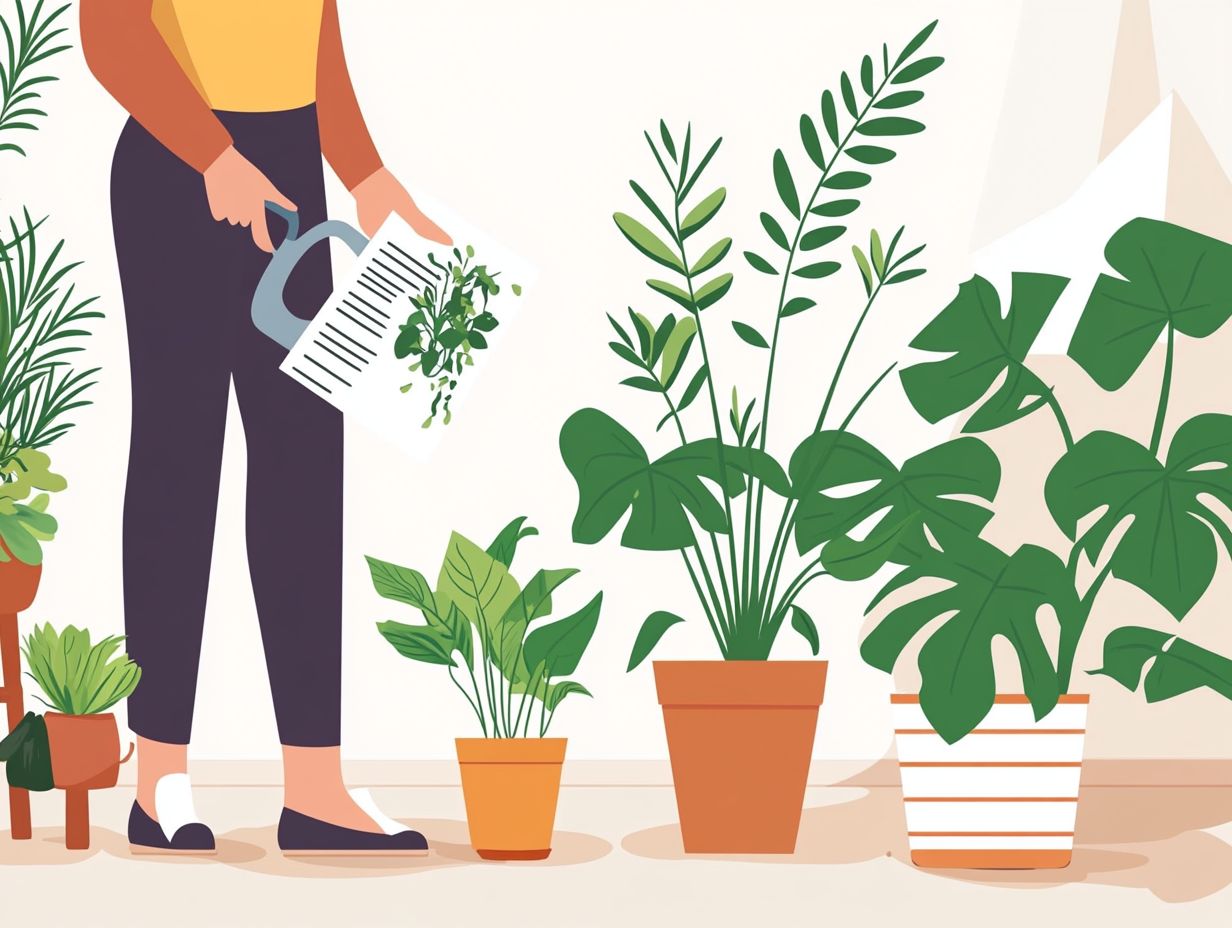
What are some common indoor plant care mistakes?
Watch out for these common indoor plant care mistakes: overwatering, not providing enough light, using the wrong type of soil, and neglecting to dust and clean the leaves regularly.
How can I prevent overwatering my indoor plants?
To prevent overwatering, check the soil moisture before watering. Only water when the top inch of soil is dry. Ensure the pot has proper drainage and avoid using decorative pots without drainage holes.
What type of soil is best for indoor plants?
Indoor plants typically do best in well-draining potting soil specifically formulated for them. Avoid garden soil, as it can be too dense and compact for potted plants.
Why are my indoor plants not growing or thriving?
If your indoor plants are not growing or thriving, it could be due to a lack of proper light, over or underwatering, or nutrient deficiencies. Assess your care routine and make adjustments as needed.
What should I do if my indoor plant’s leaves are turning yellow?
Yellowing leaves can indicate overwatering, nutrient deficiencies, or pest infestations. Check the soil moisture and ensure the plant receives enough light. If the issue persists, consider fertilizing or treating for pests.
How Can I Revive a Dying Indoor Plant?
First, find out why your plant is dying. Is it getting too much or too little water? Adjust your watering routine accordingly.
Next, check if your plant needs nutrients. If so, consider fertilizing it. If the damage is severe, repot it in fresh soil for a better chance at recovery.
Don’t give up! With a little care, your plant can bounce back. Take action now!


